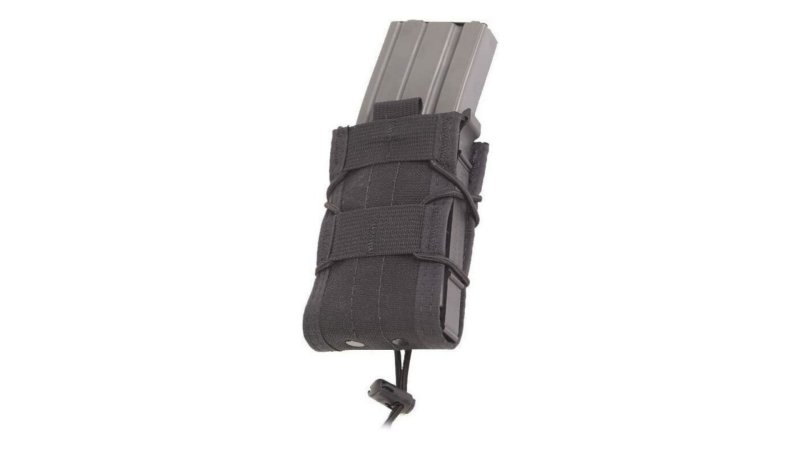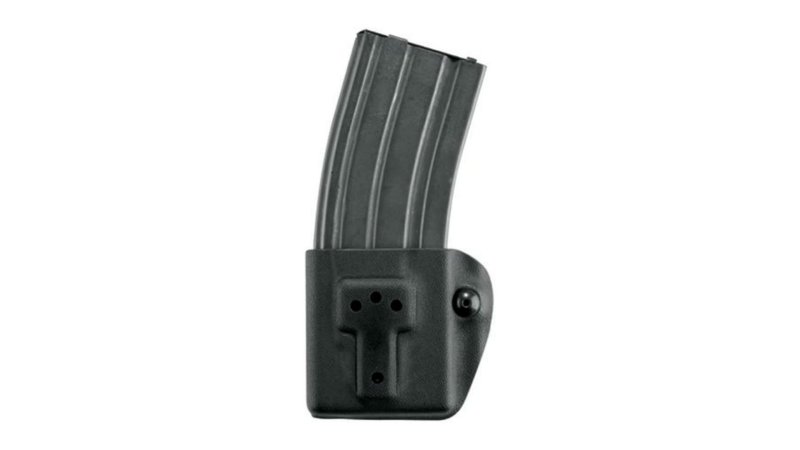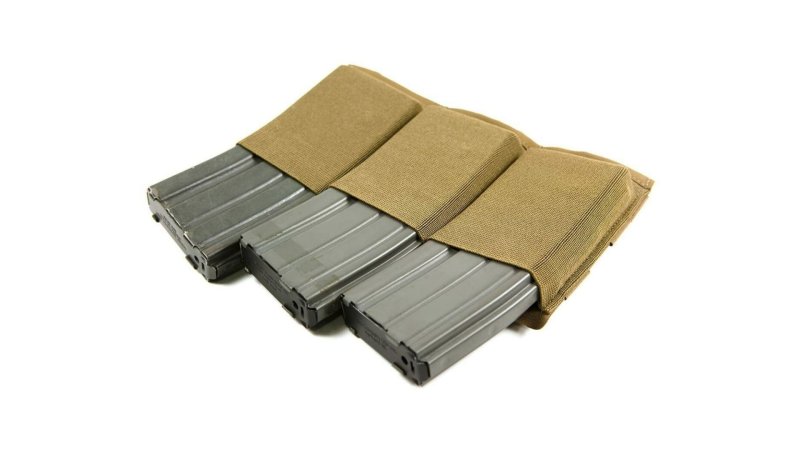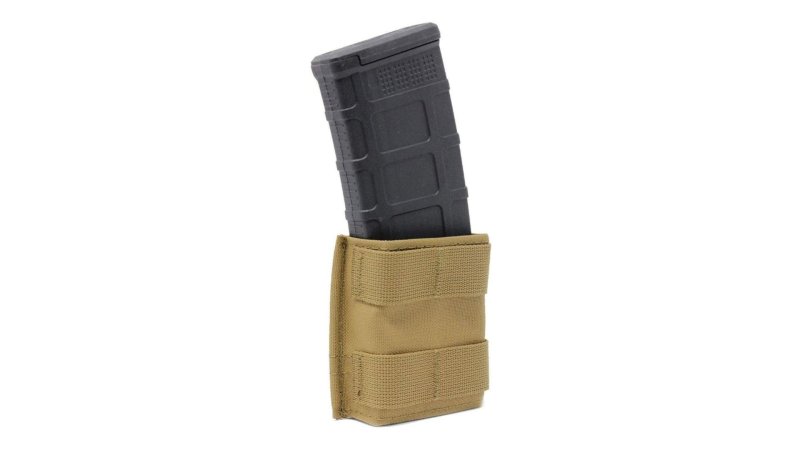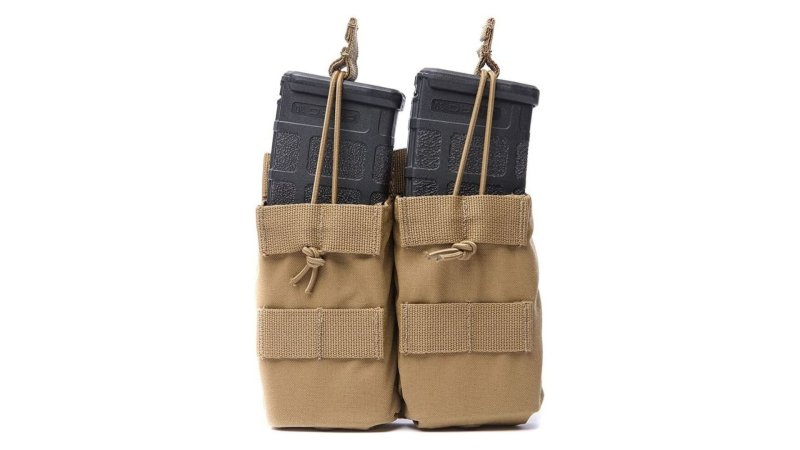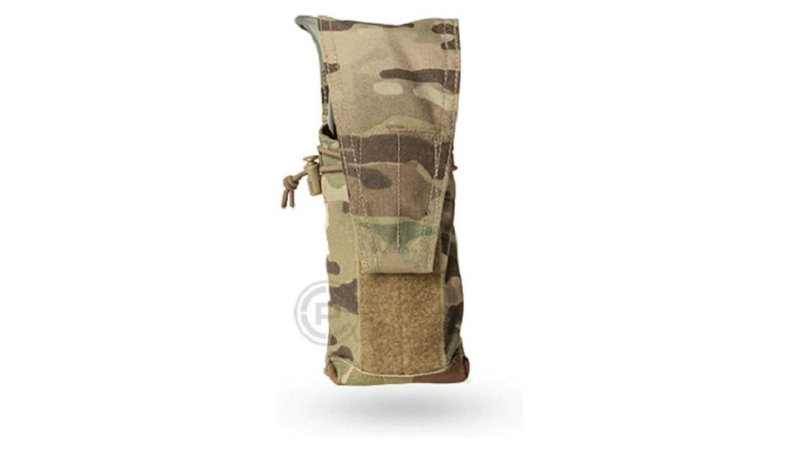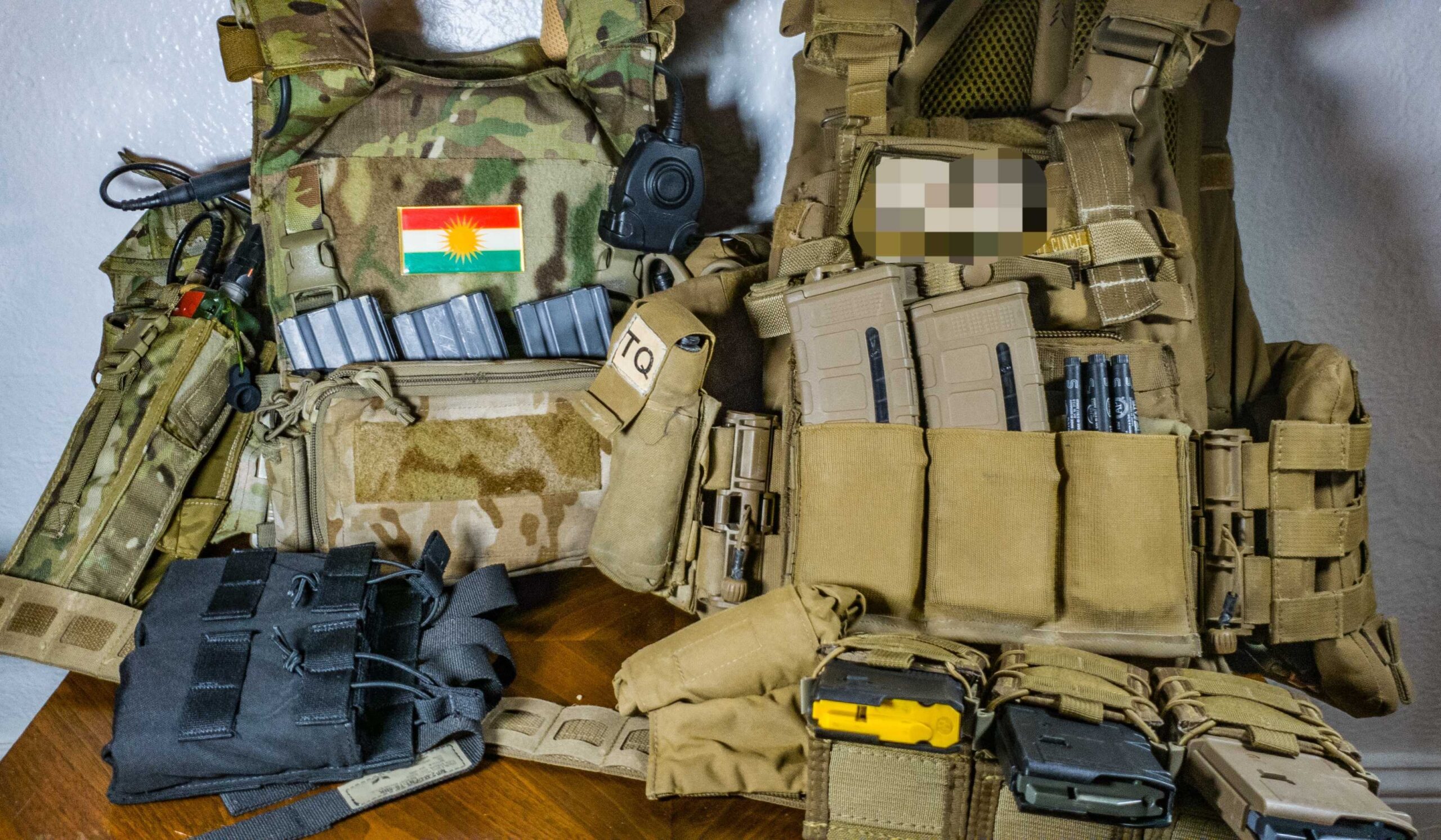

We may earn revenue from the products available on this page and participate in affiliate programs.
Dedicated magazine pouches to haul ammunition have existed for as long as firearms have been a part of warfare, and for the last half-century, the average American warfighter has utilized pouches specifically to carry the venerable STANAG magazine that feeds most of the 5.56x45mm self-loading rifles on the market.
But these aren’t the days of sloshing through the jungle with your M-1956 harness, no armor, and a bloodstream full of THC and lysergic acid. After twenty years of the War on Terror, nearly every weapons system has improved amazingly, to include magazine pouches, going beyond what previously amounted to cloth bags and featuring technologies to allow you to quickly retrieve fresh magazines without making the pouch unable to retain mags. These technologies include bungees, elastic, Kydex thermoplastic liners, and plastic claws that are all tightenable, all to the end of providing a critical balance between retention and speed.
To that end, we’ve gathered a list of some of the best AR-15 and M4 magazine pouches, no matter what your use or budget. Some of these options will be more suited to military or tactical use, while others will be better for competition shooting where factors like noise discipline and sand infiltration may not be as big of an issue. All magazine pouches presented today are made in the United States by trusted manufacturers, many of them with NSNs for military use. Because of that, the average cost may be higher, but trust me when I say it’s worth the extra cash.
I’m basing my analysis off of pouches that I’ve personally used for both leisure and military shooting, so your personal favorite may not be included. Feel free to provide your favorite in the comments below if we missed one of your preferred options.
Best Overall
HSGI Taco Pouch
Pros
- Compatible with many types of magazines
- Extremely quick to use during reloads
- Adjustable retention
- Flexible for use with different types of MOLLE mounting
Cons
- Malice clips are a pain to weave into MOLLE
- Protruding claws can dig into sides if worn on a belt
- Not as secure as closed-top pouches or purely Kydex pouches
Specs
- Manufacturer High Speed Gear
- Country of Manufacture USA
- Materials used Injection-molded polymer, nylon Cordura, and elastic shock cord
- Available colors Black, Coyote Brown, LE (Navy) Blue, Multicam, Multicam black, woodland, OD Green
Best Value
Eagle Industries Double Mag Pouch
Pros
- Compatible with many types of magazines
- Cost-effective
- Readily available
- Simple to use
Cons
- Not designed for PMAGs or other textured magazines
- Flap can slow down reloads
- No built-in retention other than the flap
- Using two magazines per pouch can be bulky
Specs
- Manufacturer Eagle Industries
- Country of Manufacture USA
- Materials used Nylon Cordura with metal snaps
- Available colors Black, Coyote Brown, LE (Navy) Blue, Multicam, Multicam black, woodland, OD Green
Best Competition
Safariland 774 Competition Rifle Magazine Pouch
Pros
- Extremely quick to use during reloads
- Adjustable retention
- Flexible for use with different types of mounting
Cons
- Plastic construction doesn’t accept some magazines, especially not when carried rounds-up
- Mounting brackets are extra, not primarily made for MOLLE usage
- Not designed for military usage, all tactical uses are secondary
Specs
- Manufacturer Safariland Group
- Country of Manufacture USA
- Materials used Kydex thermoplastic
- Available colors Black, coyote brown, flat dark earth, foliage green, olive drab
Best Lay-Flat
Blue Force Gear Ten Speed Triple Magazine Pouch
Pros
- Extremely quick to use during reloads
- Accepts nearly every 5.56mm magazine
- Completely lay-flat when not in use
Cons
- Almost impossible to re-index magazines without using two hands
- Elastic will eventually stretch too far to be useful
- Magazines can be squeezed out of the pouch while in the prone
Specs
- Manufacturer Blue Force Gear
- Country of Manufacture USA
- Materials used “Helium Whisper” elastic fabric
- Available colors Black, coyote brown, Multicam, ranger green, wolf gray
Best Hybrid
Esstac Kywi Single 5.56 Short Magazine Pouch
Pros
- Rock-solid retention with no flaps or bungees
- Flexible mounting options
- Competition-level speed with military looks
Cons
- Not compatible with every magazine type and in every configuration
- Dirt can cause the magazines to seize up
- No mounting options included
Specs
- Manufacturer Esstac
- Country of Manufacture USA
- Materials used Cordura, Kydex thermoplastic
- Available colors Multicam, Multicam Black, Multicam Arid, Multicam tropic, Woodland Marshal, Desert Marshal, Kryptek Highlander, Kryptek Typhon, M81 Woodland, Wolf Gray, Black, OD Green, Ranger Green, Coyote Brown, Tan 499, and many more
Best Secure
Eagle Industries FB Style Magazine Pouch
Pros
- Rock-solid retention
- Double retention for absolute peace of mind
- Velcro lining for Kydex prevents sand issues
Cons
- Kydex doesn’t play well with magazines other than STANAGs
- Magazine retention is extremely stiff
- Bungee option still gets in the way
Specs
- Manufacturer Eagle Industries
- Country of Manufacture USA
- Materials used Cordura, Kydex thermoplastic
- Available colors Multicam, Black, Coyote Brown
Best Multi-Purpose
Crye Precision Modular 152/Bottle/Mag Pouch
Pros
- Truly versatile for any purpose
- Fully adjustable Included
- Hypalon straps are very steady
Cons
- Expensive
- A jack of all trades is a master of none
- Too tall to rely on as a dedicated STANAG magazine pouch
Specs
- Manufacturer Crye Precision
- Country of Manufacture USA
- Materials used Cordura, Hypalon, Elastic shock cord
- Available colors Multicam, Coyote Brown, Ranger Green, Black
Why you should trust us
I’m far from the omniscient gear guru, but I know a thing or two about what works when it comes to tactical nylon. The obvious thing that jumps out to many people is going to be the fact that I’m a Marine Corps reservist, and they might assume that’s why I think I know something. Far from it, since most U.S. service members just use what they’re issued anyway, and spend the saved money on liquor and Camaros.
However, prior to enlisting in the Marine Corps, I worked for a retailer of tactical gear, and so I got exposed to many different forms of pouches, plate carriers, chest rigs, and so forth. Even now, one of my expensive hobbies that I’ve monetized is experimenting with tactical gear, and so I’m here to bring over seven years of experimentation, bad choices, and wasted money to the table to help you make a more informed decision.
On top of all this, I actually use my gear frequently at the range, so I’m constantly developing things that work for my particular shooting style. Above all else, I’m not telling you what you should do: I’m just telling you what works for me, and that maybe you might find some value in that.
Types of magazine pouches
Magazine pouches come in several configurations, only some of which are covered here. However, I’m going to do a quick rundown on the different types, what they’re usually used for, and their generalized pros and cons. In general, the types of magazine pouches can be broken down into four major groups: cloth, thermoplastic, hybrid, and leather, with the first three represented in some way on this list.
Cloth
These are the simplest, and often most cost-effective types of pouches on the market. At their core, they’re a cloth bag, usually made of nylon Cordura, with some sort of closure on top, be it a velcro flap, a snap flap, a bungee, or some other mechanism. These pouches are also the most common on the surplus market, having been around since the advent of MOLLE, and so they can be had for very cheap if you’re on a budget. The advantages that they have is that they usually work well with at least one of most magazines, and that they’re fairly easy to use for re-indexing. The disadvantage is that generally their flap closures can get in the way during reloads, and they have no form of inherent retention beyond the flap.
Thermoplastic
These pouches (or carriers as I prefer to call them, since they aren’t actually a bag) are made of flexible thermoplastic, which is a substance that includes the Kydex family of materials. This allows manufacturers to mold magazine carriers to specific magazines, firearms, and other implements, and have them securely held with no need for other retention in most cases. The advantage to this type of carrier is that they offer positive retention with no need for bungees, straps, or flaps, and instead rely on friction from the molded plastic to hold the magazine in place, which makes them some of the fastest on the list. The downside to these is that they’re often only compatible with one or two types of magazine, and aren’t flexible in allowing non-standard types of magazines, should you be a weirdo who uses G36 magazines or AUG magazines.
Hybrid
These pouches use a combination of cloth and other materials to provide their retention, whether through the use of gripping material, elastic tension, thermoplastic inserts, or some other type of solution. These pouches seek to offer a “best of both worlds” approach, and often include both thermoplastic liners and some other form of optional retention. The advantage to these pouches is that they solve the biggest issue with many of the purely cloth or purely thermoplastic options, providing a mixture of retention and flexibility. The disadvantage is largely that they inherit some of the issues of both cloth and plastic magazine carriers and the fact that they’re oftentimes still very pricey.
Leather
This isn’t an option that I discussed on this list, largely for the reason that we were speaking about rifle magazines, and the fact that I wanted every pouch on this list to have some sort of military usage. Leather is possibly the oldest ammo carrying solution, oftentimes offering intricately embossed designs, brass hardware, and other stylish choices. The advantages of leather largely boil down to style and comfort. Not much looks nicer than well-tanned and finished leather, and it’s very comfortable to wear on your belt in a concealment environment. Additionally, this may be the only option for pouches if you’re in a law enforcement environment, due to departmental restrictions or a desire for uniformity. The disadvantage of leather is that it doesn’t play well with moisture, doesn’t offer the cost-effectiveness of cloth or the rock-solid retention of thermoplastic, and has limited options for securing the pouch.
Key terms for magazine pouches
MOLLE
MOLLE stands for “MOdular Light Load-carrying Equipment” and is also known by its other name, PALS, or “Pouch Attachment Ladder System.” MOLLE functions by stitching rows of nylon straps down in 40mm increments, creating a series of loops. Through these loops, you weave straps that are found on the back of MOLLE-compatible pouches, which secures the pouch to whichever mounting surface. As an interesting aside, MOLLE is technically a proprietary term belonging to Specialty Defense Systems, and PALS is proprietary to Natick Labs. Any pouch or attachment is simply MOLLE/PALS compatible. However, you know your product is successful when everyone uses the brand name for every iteration of that product.
Retention
Retention is, simply put, how your magazine pouch keeps the magazine in unless you’re the one drawing it out. Common retention types include molded plastic, bungees, and flaps.
Kydex
Kydex is a thermoplastic material that can be precisely molded to accommodate many different types of tools and implements, while providing a certain level of inherent retention.
Hypalon
Hypalon is a type of rubber that is resistant to light, tearing, chemicals, and water, and offers flexibility, grip, and durability. It’s used in MOLLE straps to provide more grip than cloth when used against other cloth
Indexing
Indexing is a technique where a shooter takes a partially-empty magazine, and inserts it into an empty magazine pouch with the rounds facing up. This allows the shooter to distinguish between a fully-loaded magazine (rounds down) and a partially- or fully-empty magazine with a simple touch, which is very helpful to discourage the shooter from taking their attention off the downrange area, and allows easy identification in the dark.
Speed reload
A speed reload is a magazine change where the magazine that is dropped free from the weapon is not retained, in favor of loading a fresh magazine. The advantage of this is that it’s the fastest way to reload, requiring no extra steps beyond ejecting the magazine and replacing it with another. This is recommended for use when the magazine is completely empty, and there are no rounds to retain.
Tactical reload
A tactical reload is a magazine change where the ejected magazine is retained after being ejected, usually before being fully empty. This magazine is then replaced with a full one. The advantage to this technique is that it ensures all spare rounds are retained for later use, although it requires the shooter to take the extra step to retain the partially-empty magazine.
STANAG magazine
The common “GI Joe” aluminum magazine. This is the most common style of AR-15 or M4 magazine, and is the magazine that many 5.56 rifles, and almost all 5.56 military rifles in NATO, are designed around. The name stands for Standards Agreement, and it represents the accepted format of magazine that needs to be met or superseded. As a general rule, older STANAG magazines with black or green followers have followers that can tilt, which can induce stoppages or malfunctions from improperly-feeding rounds. Because of this, look for magazines with tan or blue followers, or get the Magpul follower retrofit kit.
How we chose our top picks
I chose these magazine pouches based on my experiences with pouches that I have personally owned and used. Every single pouch on this list has been on my kit in some form or another at some point in time. I left several other options off, since they either didn’t measure up, didn’t offer anything that the ones I included don’t have, or were too niche to be of much use to most of my readers. However, because of the fact that these choices are based on my experiences, my selection is limited. If you want to see my take on any of your favorite pouches, you can find my social media in the header of this article.
FAQs about magazine pouches
You’ve got questions, Task & Purpose has answers.
Q: What is a MOLLE pouch?
A: A MOLLE pouch is any pouch that can attach to MOLLE or PALS webbing by means of straps, clips, or hooks. Newer types of webbing use laser cut material where the fabric of the carrier has slots cut directly into it for mounting, which saves on weight and bulk.
Q: What MOLLE pouch does the military use?
A: Short answer is “many different types,” but in general, the MOLLE pouches that are officially sanctioned and purchased by the military must be Berry Amendment-compliant, meaning they have to be made in the USA of materials either from the USA or select allied countries. A quick way to tell is to see if the pouch in question carries an NSN, or National Stock Number. That means that the item in question has been entered into the GSA catalog, and can be purchased through official government channels. Brands that are commonly used by the military are Eagle Industries, High Speed Gear, Inc, Blue Force Gear, First Spear, S&S Precision, London Bridge Trading, Crye Precision, Tyr Tactical, and Paraclete. Every pouch on this list is made in the USA, and most of them are Berry compliant and carry an NSN.
Q: What is the best AR-15 magazine pouch?
A: Overall, the best that we tested is the HSGI Taco pouch. It balances retention with ease of use, and supports many types of magazines, while being cost effective and readily available.
Q: What is the best competition magazine pouch?
A: The best competition magazine pouch that we tested is the Safariland 774. It’s fast, lightweight, and easily mounted to regular competition belts.
Q: What’s the difference between a magazine carrier, a magazine pouch, and a magazine holster?
A: Semantics, mostly.
Our gear section
Matt Sampson is an 0861 in the Marine Forces Reserve and a Virginia native. In his past life, he worked in tactical gear retail and is an avid firearms enthusiast. The farthest the Marine Corps has sent him from home is Oklahoma.
